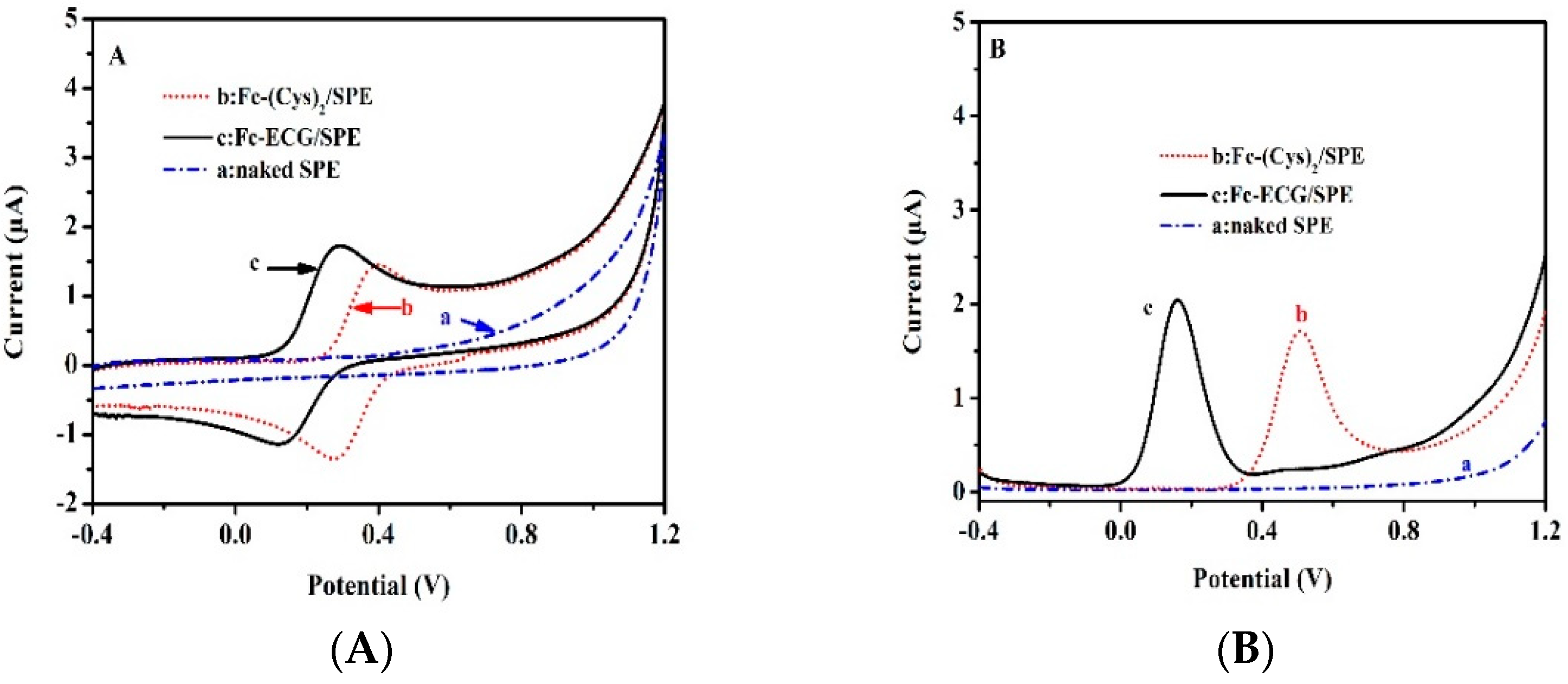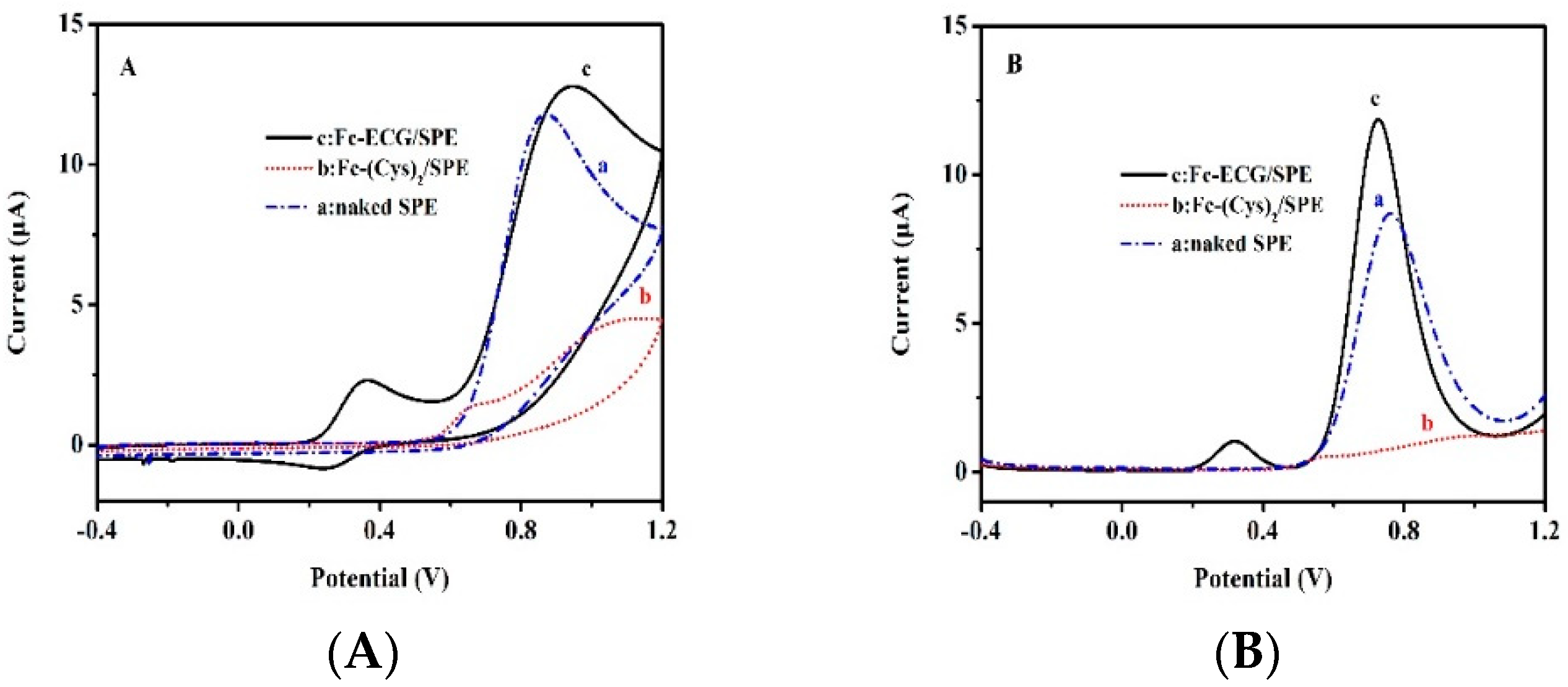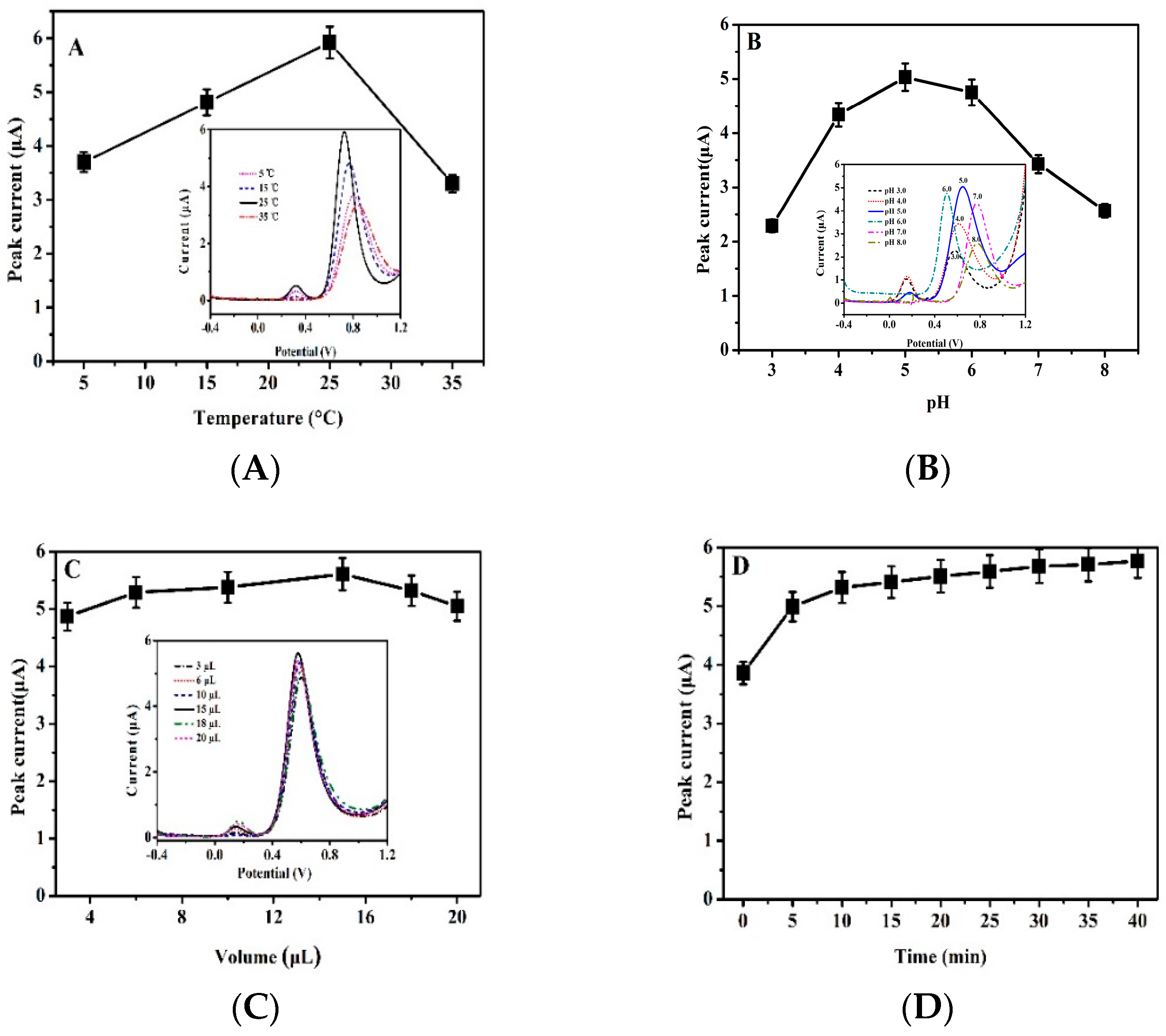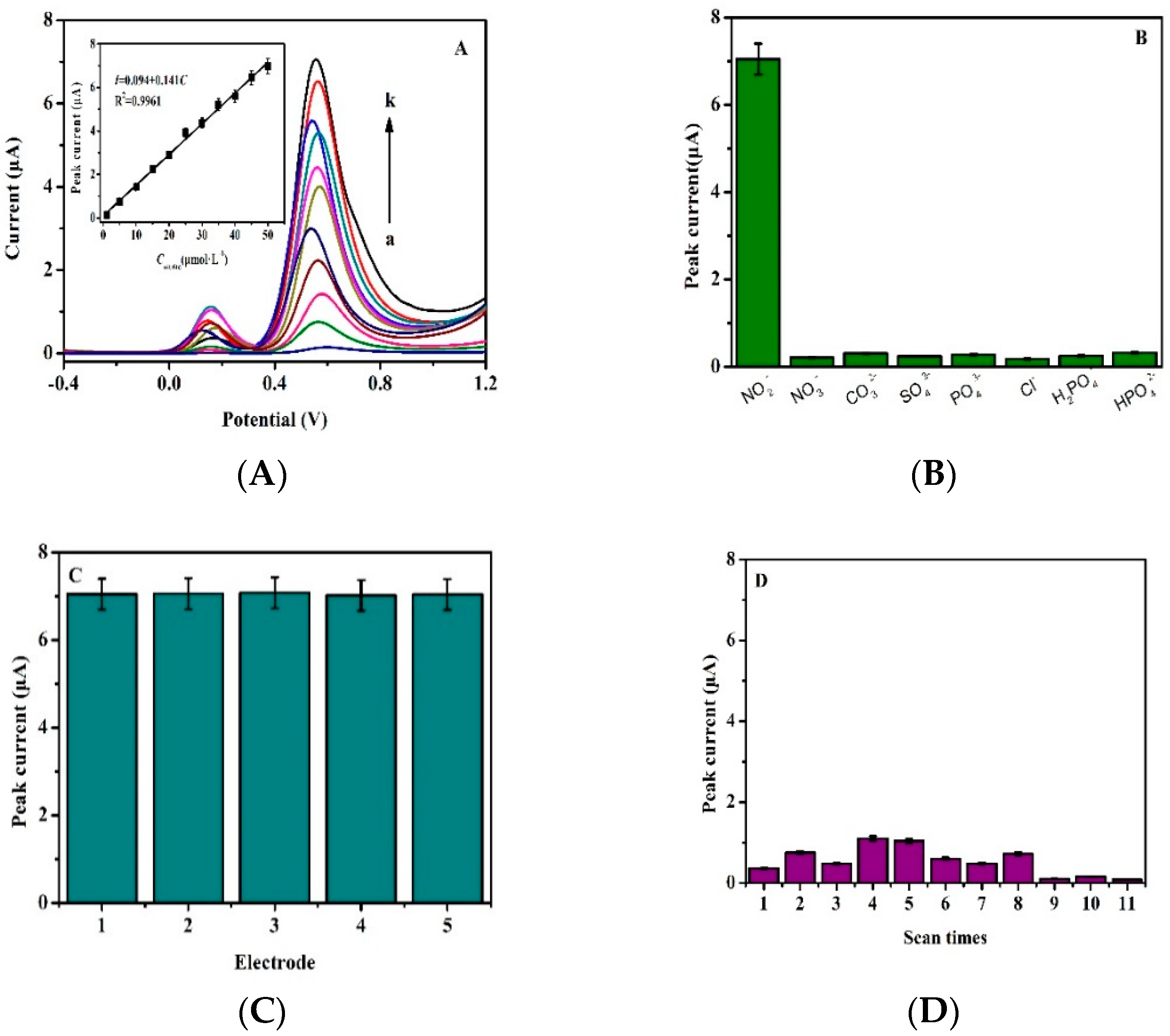A Facile Electrochemical Sensor Labeled by Ferrocenoyl Cysteine Conjugate for the Detection of Nitrite in Pickle Juice
Abstract
:1. Introduction
2. Materials and Methods
2.1. Chemicals and Reagents
2.2. Preparation of Fc(Cys)2/SPE and Fc-ECG/SPE Electrochemical Sensors
2.3. Apparatus and Electrochemical Performance
3. Results and Discussion
3.1. Characterization and Electrochemical Properties of Modified Electrodes
3.2. Electrochemical Behavior of Nitrite on the Modified Electrode
3.3. Optimization of Experimental Parameters
3.4. Nitrite Detection by Electrochemical Sensors and the Sensitivity, Selectivity, Repeatability and Stability Study
3.5. Real Sample Analysis
4. Conclusions
Author Contributions
Funding
Acknowledgments
Conflicts of Interest
References
- Alahi, M.E.E.; Mukhopadhyay, S.C.; Burkitt, L. Imprinted polymer coated impedimetric nitrate sensor for real-time water quality monitoring. Sens. Actuator B Chem. 2018, 259, 753–761. [Google Scholar] [CrossRef]
- Kesavan, S.; Kumar, D.R.; Baynosa, M.L.; Shim, J.J. Potentiodynamic formation of diaminobenzene films on an electrochemically reduced graphene oxide surface: Determination of nitrite in water samples. Mater. Sci. Eng. C Mater. 2018, 85, 97–106. [Google Scholar] [CrossRef] [PubMed]
- Arulraj, A.D.; Sundaram, E.; Vasantha, V.S.; Neppolian, B. Polypyrrole with a functionalized multi-walled carbon nanotube hybrid nanocomposite: A new and efficient nitrite sensor. New J. Chem. 2018, 42, 3748–3757. [Google Scholar] [CrossRef]
- Liu, J.Y.; Li, X.T.; Batchelor-McAuley, C.; Zhu, G.D.; Compton, R.G. Nitrite-Enhanced Charge Transfer to and from Single Polyaniline Nanotubes. Chem. Eur. J. 2017, 23, 17823–17828. [Google Scholar] [CrossRef] [PubMed]
- Zhang, L.; Li, S.B.; Zhang, Z.F.; Tan, L.C.; Pang, H.J.; Ma, H.Y. Facile fabrication of reduced graphene oxide and Keggin-type polyoxometalates nanocomposite film for high performance electrocatalytic oxidation of nitrite. J. Electroanal. Chem. 2017, 807, 97–103. [Google Scholar] [CrossRef]
- Yang, H.R.; Xiang, Y.; Guo, X.Y.; Wu, Y.P.; Wen, Y.; Yang, H.F. Diazo-reaction-based SERS substrates for detection of nitrite in saliva. Sens. Actuator B Chem. 2018, 271, 118–121. [Google Scholar] [CrossRef]
- Zan, M.H.; Rao, L.; Huang, H.M.; Xie, W.; Zhu, D.M.; Li, L.; Qie, X.W.; Guo, S.S.; Zhao, X.Z.; Liu, W.; et al. A strong green fluorescent nanoprobe for highly sensitive and selective detection of nitrite ions based on phosphorus and nitrogen co-doped carbon quantum dots. Sens. Actuator B Chem. 2018, 262, 555–561. [Google Scholar] [CrossRef]
- Wieczorek, M.; Dcbosz, M.; Swit, P.; Wozniakiewicz, A.; Koscielniak, P. Application of gradient ratio flow-injection technique to implementation of the Chemical H-point Standard Addition Method. Talanta 2018, 186, 215–220. [Google Scholar] [CrossRef] [PubMed]
- Mikuska, P.; Capka, L.; Vecera, Z. Aerosol sampler for analysis of fine and ultrafine aerosols. Anal. Chim. Acta 2018, 1020, 123–133. [Google Scholar] [CrossRef]
- Zhang, X.X.; Song, Y.Z.; Fang, F.; Wu, Z.Y. Sensitive paper-based analytical device for fast colorimetric detection of nitrite with smartphone. Anal. Bioanal. Chem. 2018, 410, 2665–2669. [Google Scholar] [CrossRef]
- Courrol, L.C.; Samad, R.E. Determination of chicken meat contamination by porphyrin fluorescence. J. Lumin. 2018, 199, 67–70. [Google Scholar] [CrossRef]
- Khatiwada, R.; Olivares, C.; Abrell, L.; Root, R.A.; Sierra-Alvarez, R.; Field, J.A.; Chorover, J. Oxidation of reduced daughter products from 2,4-dinitroanisole (DNAN) by Mn(IV) and Fe(III) oxides. Chemosphere 2018, 201, 790–798. [Google Scholar] [CrossRef] [PubMed]
- Salimi, A.; Kurd, M.; Teymourian, H.; Hallaj, R. Highly sensitive electrocatalytic detection of nitrite based on SiC nanoparticles/amine terminated ionic liquid modified glassy carbon electrode integrated with flow injection analysis. Sens. Actuator B Chem. 2014, 205, 136–142. [Google Scholar] [CrossRef]
- Wang, X.Q.; Tan, W.S.; Ji, H.; Liu, F.; Wu, D.T.; Ma, J.F.; Kong, Y. Facile electrosynthesis of nickel hexacyanoferrate/poly(2,6-diaminopyridine) hybrids as highly sensitive nitrite sensor. Sens. Actuator B Chem. 2018, 264, 240–248. [Google Scholar] [CrossRef]
- Ghanei-Motlagh, M.; Taher, M.A. A novel electrochemical sensor based on silver/halloysite nanotube/molybdenum disulfide nanocomposite for efficient nitrite sensing. Biosens. Bioelectron. 2018, 109, 279–285. [Google Scholar] [CrossRef] [PubMed]
- Manikandan, V.S.; Liu, Z.G.; Chen, A.C. Simultaneous detection of hydrazine, sulfite, and nitrite based on a nanoporous gold microelectrode. J. Electroanal. Chem. 2018, 819, 524–532. [Google Scholar] [CrossRef]
- Zhang, Y.; Wen, F.F.; Huan, Z.H.; Tan, J.; Zhou, Z.F.; Yuan, K.C.; Wang, H.G. Nitrogen doped lignocellulose/binary metal sulfide modified electrode: Preparation and application for non-enzymatic ascorbic acid, dopamine and nitrite sensing. J. Electroanal. Chem. 2017, 806, 150–157. [Google Scholar] [CrossRef]
- Hu, J.; Guo, F.; Wang, L. Voltammetric determination of nitrite by using a glassy carbon electrode modified with a self-assembled nanocomposite prepared from CdTe quantum dots, cetyltrimethylammonium bromide, chitosan and multiwalled carbon nanotubes. Microchim. Acta 2017, 184, 4637–4646. [Google Scholar] [CrossRef]
- Wang, B.B.; Ji, X.P.; Ren, J.J.; Ni, R.X.; Wang, L. Enhanced electrocatalytic activity of graphene-gold nanoparticles hybrids for peroxynitrite electrochemical detection on hemin-based electrode. Bioelectrochemistry 2017, 118, 75–82. [Google Scholar] [CrossRef]
- Bizid, S.; Mlika, R.; Said, A.H.; Chemli, M.; Youssoufi, H.K. Functionalization of MWCNTs with Ferrocene-poly(p-phenylene) and Effect on Electrochemical Properties: Application as a Sensing Platform. Electroanalysis 2016, 28, 2533–2542. [Google Scholar] [CrossRef]
- Iacob, B.C.; Bodoki, E.; Farcau, C.; Barbu-Tudoran, L.; Oprean, R. Study of the Molecular Recognition Mechanism of an Ultrathin MIP Film-Based Chiral Electrochemical Sensor. Electrochim. Acta 2016, 217, 195–202. [Google Scholar] [CrossRef]
- Manibalan, K.; Mani, V.; Chang, P.C.; Huang, C.H.; Huang, S.T.; Marchlewicz, K.; Neethirajan, S. Electrochemical latent redox ratiometric probes for real-time tracking and quantification of endogenous hydrogen sulfide production in living cells. Biosens. Bioelectron. 2017, 96, 233–238. [Google Scholar] [CrossRef] [PubMed]
- Alizadeh, T.; Akhoundian, M.; Ganjali, M.R. A ferrocene/imprinted polymer nanomaterial-modified carbon paste electrode as a new generation of gate effect-based voltammetric sensor. New J. Chem. 2018, 42, 4719–4727. [Google Scholar] [CrossRef]
- Long, Y.T.; Li, C.Z.; Sutherland, T.C.; Chahma, M.; Lee, J.S.; Kraatz, H.B. A comparison of electron-transfer rates of ferrocenoyl-linked DNA. J. Am. Chem. Soc. 2003, 125, 8724–8725. [Google Scholar] [CrossRef]
- He, X.P.; Wang, X.W.; Jin, X.P.; Zhou, H.; Shi, X.X.; Chen, G.R.; Long, Y.T. Epimeric Monosaccharide-Quinone Hybrids on Gold Electrodes toward the Electrochemical Probing of Specific Carbohydrate-Protein Recognitions. J. Am. Chem. Soc. 2011, 133, 3649–3657. [Google Scholar] [CrossRef] [PubMed]
- Shuai, H.L.; Huang, K.J.; Xing, L.L.; Chen, Y.X. Ultrasensitive electrochemical sensing platform for microRNA based on tungsten oxide-graphene composites coupling with catalyzed hairpin assembly target recycling and enzyme signal amplification. Biosens. Bioelectron. 2016, 86, 337–345. [Google Scholar] [CrossRef]
- Han, G.C.; Ferranco, A.; Feng, X.Z.; Chen, Z.C.; Kraatz, H.B. Synthesis, Characterization of Some Ferrocenoyl Cysteine and Histidine Conjugates, and Their Interactions with Some Metal Ions. Eur. J. Inorg. Chem. 2014, 2014, 5337–5347. [Google Scholar] [CrossRef]
- Han, G.C.; Su, X.R.; Hou, J.T.; Ferranco, A.; Feng, X.Z.; Zeng, R.S.; Chen, Z.C.; Kraatz, H.B. Disposable electrochemical sensors for hemoglobin detection based on ferrocenoyl cysteine conjugates modified electrode. Sens. Actuator B Chem. 2019, 282, 130–136. [Google Scholar] [CrossRef]
- Balasubramanian, P.; Settu, R.; Chen, S.M.; Chen, T.W.; Sharmila, G. A new electrochemical sensor for highly sensitive and selective detection of nitrite in food samples based on sonochemical synthesized Calcium Ferrite (CaFe2O4) clusters modified screen printed carbon electrode. J. Colloid Interface Sci. 2018, 524, 417–426. [Google Scholar] [CrossRef]
- Cao, L.L.; Fang, C.; Zeng, R.S.; Zhao, X.J.; Jiang, Y.R.; Chen, Z.C. Paper-based microfluidic devices for electrochemical immunofiltration analysis of human chorionic gonadotropin. Biosens. Bioelectron. 2017, 92, 87–94. [Google Scholar] [CrossRef]
- Cao, L.L.; Fang, C.; Zeng, R.S.; Zhao, X.J.; Zhao, F.J.; Jiang, Y.R.; Chen, Z.C. A disposable paper-based microfluidic immunosensor based on reduced graphene oxide-tetraethylene pentamine/Au nanocomposite decorated carbon screen-printed electrodes. Sens. Actuator B Chem. 2017, 252, 44–54. [Google Scholar] [CrossRef]
- Mani, V.; Periasamy, A.P.; Chen, S.M. Highly selective amperometric nitrite sensor based on chemically reduced graphene oxide modified electrode. Electrochem. Commun. 2012, 17, 75–78. [Google Scholar] [CrossRef]
- Pham, X.H.; Li, C.A.; Han, K.N.; Huynh-Nguyen, B.C.; Le, T.H.; Ko, E.; Kim, J.H.; Seong, G.H. Electrochemical detection of nitrite using urchin-like palladium nanostructures on carbon nanotube thin film electrodes. Sens. Actuator B Chem. 2014, 193, 815–822. [Google Scholar] [CrossRef]
- Zhang, Y.; Nie, J.T.; Wei, H.Y.; Xu, H.T.; Wang, Q.; Cong, Y.Q.; Tao, J.Q.; Zhang, Y.; Chu, L.L.; Zhou, Y.; et al. Electrochemical detection of nitrite ions using Ag/Cu/MWNT nanoclusters electrodeposited on a glassy carbon electrode. Sens. Actuator B Chem. 2018, 258, 1107–1116. [Google Scholar] [CrossRef]
- Losada, J.; Armada, M.P.G.; Garcia, E.; Casado, C.M.; Alonso, B. Electrochemical preparation of gold nanoparticles on ferrocenyl-dendrimer film modified electrodes and their application for the electrocatalytic oxidation and amperometric detection of nitrite. J. Electroanal. Chem. 2017, 788, 14–22. [Google Scholar] [CrossRef]
- Ning, D.L.; Zhang, H.F.; Zheng, J.B. Electrochemical sensor for sensitive determination of nitrite based on the PAMAM dendrimer-stabilized silver nanoparticles. J. Electroanal. Chem. 2014, 717, 29–33. [Google Scholar] [CrossRef]
- Jiang, J.J.; Fan, W.J.; Du, X.Z. Nitrite electrochemical biosensing based on coupled graphene and gold nanoparticles. Biosens. Bioelectron. 2014, 51, 343–348. [Google Scholar] [CrossRef]






| Modified Electrode | Peak Potential (V) | pH | Detection Limit (μmol·L−1) | Linear Range (μmol·L−1) | Reference |
|---|---|---|---|---|---|
| CR-GO/GCE | 0.8 a | 5.0 | 1.0 | 8.9–167 | [32] |
| Pd/SWCNT | 0.75 a | 4.0 | 0.25 | 2–238 | [33] |
| CFO/SPCE | 0.8 a | 5.0 | 0.007 | 0.016–1921 | [29] |
| Ag/Cu/MWNT/GCE | 0.85 a | 7.0 | 0.2 | 1.0–1000 | [34] |
| Dendrimer/AuNPs/GC | 0.85 b | 5.0 | 0.2 | 10–5000 | [35] |
| Ag-PAMAM/GCE | 0.8 b | 6.0 | 0.4 | 4.0–1440 | [36] |
| Hb/Au/GACS/GCE | 0.85 b | 7.0 | 0.01 | 0.05–1000 | [37] |
| Fc-ECG/SPE | 0.55 a | 5.0 | 0.3 | 1.0–50 | This work |
| Analyte | Detected (μmol·L−1) | Added (μmol·L−1) | Found (μmol·L−1) | Average Recovery (%) | RSD (%) |
|---|---|---|---|---|---|
| Pickle juice | 20.0 ± 0.4 | 10.0 | 30.4 ± 0.8 | 101.4 | 2.1 |
| 20.0 | 40.3 ± 0.9 | 100.9 | 1.8 |
© 2019 by the authors. Licensee MDPI, Basel, Switzerland. This article is an open access article distributed under the terms and conditions of the Creative Commons Attribution (CC BY) license (http://creativecommons.org/licenses/by/4.0/).
Share and Cite
Feng, X.-Z.; Ferranco, A.; Su, X.; Chen, Z.; Jiang, Z.; Han, G.-C. A Facile Electrochemical Sensor Labeled by Ferrocenoyl Cysteine Conjugate for the Detection of Nitrite in Pickle Juice. Sensors 2019, 19, 268. https://doi.org/10.3390/s19020268
Feng X-Z, Ferranco A, Su X, Chen Z, Jiang Z, Han G-C. A Facile Electrochemical Sensor Labeled by Ferrocenoyl Cysteine Conjugate for the Detection of Nitrite in Pickle Juice. Sensors. 2019; 19(2):268. https://doi.org/10.3390/s19020268
Chicago/Turabian StyleFeng, Xiao-Zhen, Annaleizle Ferranco, Xiaorui Su, Zhencheng Chen, Zhiliang Jiang, and Guo-Cheng Han. 2019. "A Facile Electrochemical Sensor Labeled by Ferrocenoyl Cysteine Conjugate for the Detection of Nitrite in Pickle Juice" Sensors 19, no. 2: 268. https://doi.org/10.3390/s19020268
APA StyleFeng, X.-Z., Ferranco, A., Su, X., Chen, Z., Jiang, Z., & Han, G.-C. (2019). A Facile Electrochemical Sensor Labeled by Ferrocenoyl Cysteine Conjugate for the Detection of Nitrite in Pickle Juice. Sensors, 19(2), 268. https://doi.org/10.3390/s19020268







